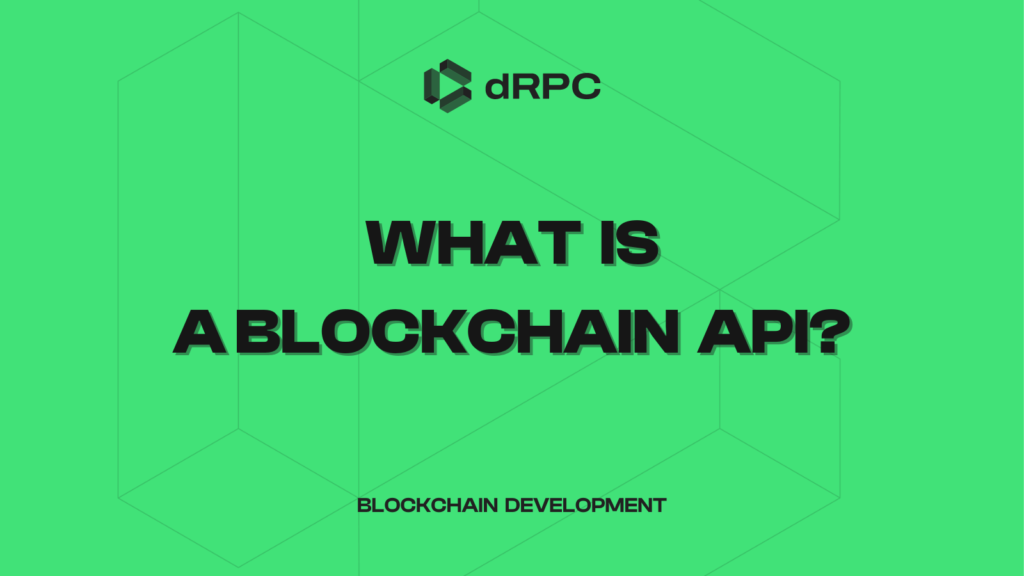Blockchain APIs acts as the key link between blockchains and applications that use onchain data. This article gives a clear explanation of what a Blockchain API is, how it simplifies blockchain interactions, and why it is a crucial part of building scalable, secure Web3 projects.
You will get an easy-to-understand overview of its structure, main benefits, and real-world uses, helping you choose the right blockchain integration tools. Whether you are a developer or a project leader, this guide offers practical advice to improve your blockchain infrastructure plan.
Core functioning
So, as said, Blockchain APIs acts as the main link that connects applications to blockchain networks. Without it, developers would have to deal with different protocols, data formats, and communication methods unique to each blockchain. Think of a Blockchain API as a common controller that simplifies these differences, allowing smooth interaction across various networks.
By handling the technical details—like cryptographic steps, consensus methods, and node functions—Blockchain APIs let developers and organizations focus on building new solutions. This simplification turns a scattered and technical environment into an easy-to-use platform, even for teams without deep blockchain experience.
Using Blockchain APIs ensures steady and standard communication, which leads to reliability and growth. Applications that use these APIs get consistent data formats and protocols, reducing mistakes and improving performance. This steadiness is important for businesses and Web3 projects that need safe, fast, and reliable access to blockchain data—whether for checking transactions, managing wallets, or running smart contracts.
In short, a Blockchain API works as the key translator between blockchain networks and modern applications. It gives developers the tools to use blockchain features quickly and safely, supporting the growth of decentralized technologies with accuracy and trust.
Understanding the Technical Architecture and Workflow
Blockchain APIs work through a simple and reliable request-response process that allows smooth communication between applications and blockchain networks. Here’s how it works:
-
Request: The client application sends a call to a specific API endpoint. This call can ask for transaction details, manage wallets, or activate smart contract functions. Each endpoint is linked to a particular blockchain task, identified by a unique URL.
-
Processing: When the API server gets the request, it checks the client’s credentials and permissions to keep security intact. Then, it carries out the request by querying the blockchain or performing the needed action.
-
Response: The API returns the requested data or confirmation in a consistent format—usually JSON—making it easy for the client application to use and understand.
Security is a key part of API design. To protect the system and user data, Blockchain APIs use rate limiting to control traffic, apply strong authentication protocols to confirm user identity, and include protections like front-running prevention to stop misuse of transaction information by bad actors.
Think of this process as a clear conversation: your application sends a question (request), the API checks your identity and gets the data (processing), then replies with a clear, standard answer (response). This straightforward exchange helps developers create reliable and secure blockchain applications without dealing with the details of the network itself.
Key Benefits
Blockchain APIs offer important advantages that make Web3 project development easier and faster. By handling the technical details of blockchain protocols, they let developers focus on building features instead of dealing with complex backend processes. This leads to quicker integration and shorter time-to-market, which is crucial in today’s fast-moving environment.
As your project grows, Blockchain APIs provide the scalability and reliable performance needed to support more users without losing speed. They also help connect older Web2 systems with new Web3 platforms, creating a smooth link for both large companies and startups.
|
User Type |
Easy Development |
Faster Integration |
Scalability & Reliability |
|
Developers |
Removes blockchain protocol challenges |
Quick API endpoints for feature release |
Handles high data loads |
|
Enterprises |
Reduces technical barriers |
Speeds up deployment |
Ensures uptime and data accuracy |
|
Startups |
Offers easy onboarding |
Supports fast MVP launches |
Allows growth without redesign |
|
Analytics Platforms |
Gives simple access to blockchain data |
Integrates live data streams |
Provides steady, reliable data |
Exploring Practical Applications
Blockchain APIs act as the foundation for many innovative applications across different industries. In the case of cryptocurrency exchanges, these APIs provide real-time data on price feeds, transaction confirmations, and wallet balances, allowing smooth trading and secure asset management. For example, a leading exchange uses Blockchain APIs to update user balances instantly, greatly reducing transaction delays.
Decentralized applications (DApps) rely on Blockchain APIs to connect easily with smart contracts and support user onboarding. A popular DeFi platform uses these APIs to carry out complex financial transactions while keeping the user experience simple.
Analytics and monitoring tools use Blockchain APIs to track network activity and gather useful insights. This data helps projects improve system performance and quickly spot any unusual behavior.
Businesses create custom solutions for compliance, reporting, and process automation by using Blockchain APIs, ensuring they meet regulatory requirements and increase efficiency without manual work.
These examples show how Blockchain APIs help developers and organizations speed up innovation while maintaining security and reliability.
Comparing Blockchain APIs and RPC: Choosing the Best Option for Your Project
Choosing between a Blockchain API and direct RPC calls depends on what your project needs. Blockchain APIs offer a simpler way to connect, making them ideal for apps like wallets, exchanges, and analytics tools. They come with built-in security and provide a consistent experience for developers through standard interfaces. On the other hand, RPC allows direct communication with blockchain nodes, which is better suited for node operators or projects that need detailed control and custom queries. We also have an article where we explain how to choose RPC provider.
|
Aspect |
Blockchain API |
RPC |
|
Abstraction Level |
High – hides underlying details |
Low – direct node interaction |
|
Use Cases |
Apps, analytics, exchanges |
Node management, custom queries |
|
Security |
Built-in protections |
Depends on node setup |
|
Developer Experience |
Consistent and easy to use |
Needs advanced blockchain knowledge |
Conclusion
Understanding what a Blockchain API is and how it works is key to building strong and scalable Web3 applications. In this chapter, we have discussed:
-
The main role of Blockchain APIs as connectors that make blockchain integration easier.
-
The technical steps that ensure safe and smooth data exchange using standard request-response methods.
-
Key benefits such as faster development, better scalability, and easy compatibility with different needs.
-
Real-world uses showing how APIs help exchanges, decentralized apps, analytics tools, and business-level solutions.
-
The difference between Blockchain APIs and direct RPC calls, helping to choose the right method.
Using Blockchain APIs gives developers and companies dependable, fast access to blockchain data without losing security. This setup supports growth and improves the Web3 ecosystem. At dRPC, we focus on providing clear, accurate infrastructure solutions that help creators focus on building decentralized technology with confidence.


